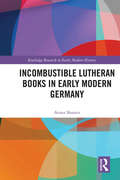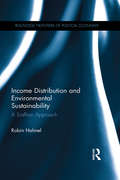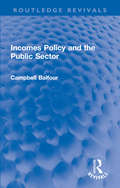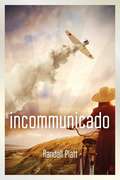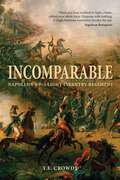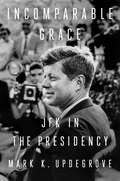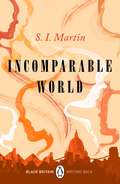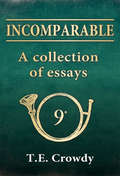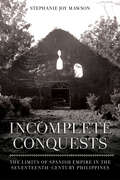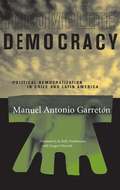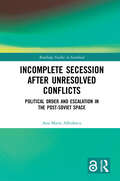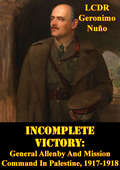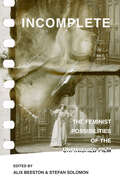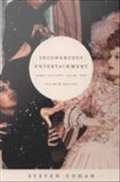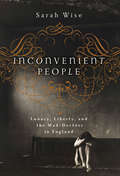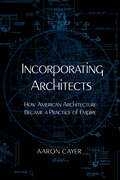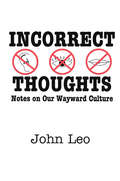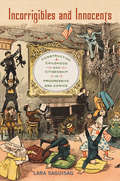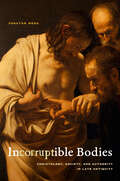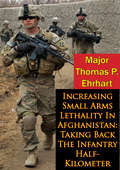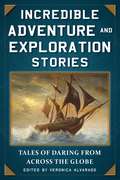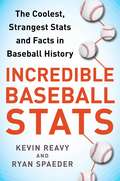- Table View
- List View
Incombustible Lutheran Books in Early Modern Germany
by Avner ShamirThis book discusses the early modern engagement with books that survived intentional or accidental fire in Lutheran Germany. From the 1620s until the middle of the eighteenth century, unburnt books became an attraction for princes, publishers, clergymen, and some laymen. To cope with an event that seemed counter-intuitive and possibly supernatural, contemporaries preserved these books, narrated their survival, and discussed their significance. This book demonstrates how early modern Europeans, no longer bound to traditional medieval religion, yet not accustomed to modern scientific ways of thinking, engaged with a natural phenomenon that was not uncommon and yet seemed to defy common sense.
Income Distribution and Environmental Sustainability: A Sraffian Approach (Routledge Frontiers of Political Economy)
by Robin HahnelAny economics that does not deal forthrightly with economic inequality is no longer suitable for the twenty-first century. Similarly, any economics which does not provide a coherent way to integrate environmental sustainability into economic analysis will fail to command allegiance in the century ahead. This book demonstrates how the Sraffian framework provides important advantages in both areas. Divided into three chapters, Income Distribution and Environmental Sustainability provides a rigorous exposition of Sraffian theory emphasizing what it means for the economy to be productive, extends Sraffian theory to address environmental sustainability, and adds a normative theory of income distribution to Sraffa’s positive theory. In Chapter 1, a rigorous version of the basic Sraffa model is presented which focuses on what it means for the economy to be capable of producing a physical surplus, explains the origin of profits, and shows how to measure changes in overall labor productivity resulting from any technical change. In Chapter 2, the basic model is extended to incorporate primary inputs from the natural environment, rigorously measure changes in environmental throughput efficiency, and establish sufficient conditions for environmental sustainability. In Chapter 3, an explicit "normative" theory of economic justice is elaborated which is a natural extension of Sraffa’s "positive" theory of income determination and consistent with modern egalitarian literature on distributive justice. This book is of interest to academics and students who study political economy, economic theory, and philosophy, as well as those interested in the work of Piero Sraffa.
Income Distribution, Growth and Basic Needs in India (Routledge Library Editions: British in India #11)
by Mary Gregory Peter Pearson R. Sinha Gopal KadekodiThis book, first published in 1979, explores the sources and patterns of the distribution of personal incomes in India, between rural and urban areas and among socio-economic classes, differentiating particularly those groups falling below the poverty line.
Incomes Policy and the Public Sector (Routledge Revivals)
by Campbell BalfourOriginally published in 1972, Incomes Policy and the Public Sector is a consideration of the work conducted by The National Board for Prices and Incomes from 1965 to 1970. The Board, commonly known as the PIB, was intended to be the instrument through which an incomes policy could be shaped and guided in Britain. This book looks first at the reports that it made, and the criteria and judgements used, and then examines incomes policy by studying its impact in several areas in the public sector. Incomes Policy and the Public Sector offers a comprehensive overview of incomes policy from 1965-1970 and puts the reader in touch with ‘real economic situations’.
Incommunicado
by Randall PlattJust about everyone is incommunicado in the small, sleepy Oregon coastal town of Sea Park during winter. Until Pearl Harbor, that is, when it springs to patriotic life. But is Ruby Opal Pearl (a.k.a. Jewels) Stokes the only person to see what's really happening here? Tommy Kasamoto, the one person in her life who has provided security, shelter, and a smidgeon of respect-and who owns the biggest resort on the coast-is now the cause of the town's rage. Tommy's Japanese ancestry makes him the prime target of an angry mob, not to mention he's also rich, has a shady past, and everyone in town owes him money. As the town's patriotism blossoms into paranoia and turns violent, Jewels has to do something to protect Tommy from internment (or worse), even if that something is going up against the town and the government, not to mention the FBI. Thus begins a fourteen-year-old girl's war within a war.Randall Platt's Incommunicado is both timely and timeless. It's about the meaning of courage and the willingness to stand up for what's right, even when it goes against the prevailing attitudes of the time and place. It's also about the insidious way groups and communities can nurture ignorance and prejudice. But most of all, it's an adventure story set in a town full of unforgettable characters, during a time of great intrigue and peril, no matter which enemy or on what front you fight.
Incomparable
by Terry CrowdyFrance's 9th Light Infantry regiment was created as an elite battalion in Louis XVI's Royal Army. After the aristocratic officers fled from the Revolution, command of the battalion fell to a close-knit group of grizzly ex-NCOs, idealistic revolutionaries and a young, battle-scarred captain, Mathieu Labassée. In 1799, as First Consul of the Republic, Napoleon needed a military victory to cement his political power. He drove a hastily gathered army across the Swiss Alps to recapture northern Italy from the Austrians. It was a risky gamble which very nearly failed. At Marengo Napoleon is taken by surprise. His army were in open retreat when the Ninth arrived late on the field. As Napoleon's last hope they were launched forward to stop the Austrians and give the rest of the army time to recover. Their charge was so ferocious it breaks Austrian morale and precipitates their headlong flight from the battlefield.With the crown of France within his reach, Napoleon was generous in his praise for the Ninth, dubbing them 'Incomparable'. They were feted as celebrities in Paris, but success went to their heads, some officers turned to drink, others fought duels against rivals in Napoleon's Guard. A new commander, Claude Meunier was brought in to bring about change: The Ninth's prestige was now at its peak.From such heady heights, the fear of failure became a powerful motivator. Through successive campaigns in Austria, Prussia, Poland and Spain, the regiment proved its worth. Eventually the strain began to show. The misery of guerrilla war sucks the life and soul out of the regiment. By the time the Allies reached Paris in 1814, the regiment could muster only a handful of men capable of holding their place in the line. They fight on, regardless. In 1815 Napoleon returns from exile in Elba. The Ninth immediately acclaim his return and take their cherished Eagle out of hiding, promising once again to conquer or die. The climax of the book comes ten miles from Waterloo on a bridge over the River Dyle. The Ninth spearheaded the charge to rejoin Napoleon. Like Marengo, their late arrival might save the day. Unlike Marengo, they fail. Even in defeat their story is extraordinary - even by the standards of the dramatic and turbulent years in which they lived.This is not a traditional regimental history. It is the story of people who were caught up in the blazing trail of Napoleon's epic career. It describes the Napoleonic war machine from within, shedding light on the lives and feats of soldiers on whose toil a spectacular Empire was built and lost.
Incomparable Grace: JFK in the Presidency
by Mark K. UpdegroveAcclaimed author and historian Mark K. Updegrove, head of the LBJ Foundation and presidential historian for ABC News, offers an illuminating account of John F. Kennedy&’s brief but transformative tenure in the White House. &“Tremendously absorbing and inviting… An important book.&”—Doris Kearns Goodwin • &“Elegant, concise, [and] knowing.&”—Michael Beschloss • &“Rescues JFK from Camelot mythology.&”—Richard Norton Smith Nearly sixty years after his death, JFK still holds an outsize place in the American imagination. While Baby Boomers remember his dazzling presence as president, millennials more likely know him from advertisements for Omega watches or Ray Ban sunglasses. Yet his years in office were marked by more than his style and elegance. His presidency is a story of a fledgling leader forced to meet unprecedented challenges, and to rise above missteps to lead his nation into a new and hopeful era. Kennedy entered office inexperienced but alluring, his reputation more given by an enamored public than earned through achievement. In this gripping new assessment of his time in the Oval Office, Updegrove reveals how JFK&’s first months were marred by setbacks: the botched Bay of Pigs invasions, a disastrous summit with the Soviet premier, and a mismanaged approach to the Civil Rights movement. But the young president soon proved that behind the glamour was a leader of uncommon fortitude and vision. A humbled Kennedy conceded his mistakes, and, importantly for our times, drew important lessons from his failures that he used to right wrongs and move forward undaunted. Indeed, Kennedy grew as president, radiating greater possibility as he coolly faced a steady stream of crises before his tragic end. Incomparable Grace compellingly reexamines the dramatic, consequential White House years of a flawed but gifted leader too often defined by the Camelot myth that came after his untimely death.
Incomparable World: A collection of rediscovered works celebrating Black Britain curated by Booker Prize-winner Bernardine Evaristo (Black Britain: Writing Back #1)
by S. I. MartinA visceral reimagining of 1780s London, showcasing the untold stories of African-American soldiers grappling with their post-war freedom 'Remarkable' David DabydeenIn the years just after the American revolution, London was the unlikely refuge for thousands of black Americans who fought for liberty on the side of the British.Buckram, Georgie and William have earned their freedom and escaped their American oppressors, but on the streets of London, poverty awaits with equal cruelty.Ruthless, chaotic and endlessly evolving, London forces them into a life of crime, and a life on the margins. Their only hope for a better future is to concoct a scheme so daring, it will be a miracle if it pays off.Bursting with energy and vivid detail, Incomparable World boldly uncovers a long-buried narrative of black Britain.'Adventurous and exuberant . . . a rollicking thriller [that] pulsates with vivacity' Bernardine EvaristoSelected by Booker Prize-winning author Bernardine Evaristo, this series rediscovers and celebrates pioneering books depicting black Britain that remap the nation.
Incomparable: a collection of essays
by Terry CrowdyAn elite battalion under Louis XVI, the 9th Light Infantry regiment were with Napoleon from almost the beginning of his campaigns, so much so that he dubbed them 'Incomparable'. This collection of essays studies their early history and formation, prior to being so vital during the Napoleonic Wars.
Incomplete Conquests: The Limits of Spanish Empire in the Seventeenth-Century Philippines
by Stephanie Joy MawsonIn Incomplete Conquests, Stephanie Joy Mawson uncovers the limitations of Spanish empire in the Philippines, unearthing histories of resistance, flight, evasion, conflict, and warfare from across the breadth of the Philippine archipelago during the seventeenth century. The Spanish colonization of the Philippines that began in 1565 has long been seen as heralding a new era of globalization, drawing together a multiethnic world of merchants, soldiers, sailors, and missionaries. Colonists sent reports back to Madrid boasting of the extraordinary number of souls converted to Christianity and the number of people paying tribute to the Spanish Crown. Such claims constructed an imagined imperial sovereignty and were not accompanied by effective consolidation of colonial control in many of the regions where conversion and tribute collection were imposed. Incomplete Conquests foregrounds the experiences of indigenous, Chinese, and Moro communities and their responses to colonial agents, weaving together stories that take into account the rich cultural and environmental diversity of this island world.
Incomplete Democracy
by Manuel Antonio GarretónOne of Latin America's leading sociologists, Manuel Antonio Garreton explores contemporary challenges to democratization in Latin America in this work originally published in Spanish in 1995. He pays particular attention to the example of Chile, analyzing the country's return to democracy and its hopes for continued prosperity following the 1973 coup that overthrew democratically elected president Salvador Allende. Garreton contends that the period of democratic crisis and authoritarian rule that characterized much of Latin America in the 1960s and 1970s was symptomatic of a larger breakdown in the way society and government worked. A new era emerged in Chile at the end of the twentieth century, Garreton argues--an era that partakes of the great changes afoot in the larger world. This edition updates Garreton's analysis of developments in Chile, considering the administration of current president Ricardo Lagos. The author concludes with an exploration of future prospects for democracy in Latin America.
Incomplete Secession after Unresolved Conflicts: Political Order and Escalation in the Post-Soviet Space (Routledge Studies in Statehood)
by Ana Maria AlbulescuThis book analyses cases of incomplete secession after separatist wars and what this means for relations between central governments and de facto states. The work explores the interplay between violence and power by examining the micro-dynamics inherent in the process of escalation between separatists and central governments. These dynamics affect not only the security interactions between these entities, but also the character of political and governance relations that are built in the aftermath of secessionist war. The book provides comprehensive analyses of the evolution of post-conflict relations between the Republic of Moldova and Transnistria and between Georgia and South Ossetia and Abkhazia. Beyond these empirical and conceptual examples, the book contributes to a key debate in International Relations that addresses the relationship between democratisation, nationalism and violence, and its applicability to the study of escalation in the post-Soviet space. This book will be of much interest to students of secession, statehood, conflict studies, democratisation, post-Soviet politics and International Relations in general.
Incomplete Victory: General Allenby And Mission Command In Palestine, 1917-1918
by Lcdr Geronimo NuñoThe Palestine Campaign of the First World War exhibited a fighting style that brought with it various challenges in mission command. While General Allenby, commanding the Allied Egyptian Expeditionary Force (EEF), gained several victories in the early stages of the campaign, he did not comprehensively defeat the Turkish forces in Palestine. He drove them away from their defensive line, but they escaped, avoided destruction, and retreated north to re-establish a defense and engage the EEF at later date. This thesis argues that General Allenby did not achieve the great successes at the battles of Beersheba, Gaza, Sheria, and the pursuit of Turkish forces that ended with Allenby's capture of Jerusalem. Instead, Allenby had to learn how to succeed in Palestine to finally destroy the armies of the Ottoman Empire in Palestine at the battle of Megiddo in September 1918. The research in this study highlights the mission command challenges in Allenby's early campaigns and how he learned to overcome them and adapt his tactics to achieve complete victory at the battle of Megiddo. This thesis will use the tenets of mission command, consisting preparation, combined arms, prioritization of resources, and communication, to examine General Allenby's Palestine campaign. Mission command, both a function of war and a philosophy of leadership comprises one of the key facets of military thought that leaders must consider in order to achieve complete victory.
Incomplete: The Feminist Possibilities of the Unfinished Film (Feminist Media Histories #5)
by Alix Beeston and Stefan SolomonThis field-defining collection establishes unfinished film projects—abandoned, interrupted, lost, or open-ended—as rich and underappreciated resources for feminist film and media studies. In deeply researched and creatively conceived chapters, scholars join with film practitioners in approaching the unfinished film as an ideal site for revealing the lived experiences, practical conditions, and institutional realities of women's film production across historical periods and national borders. Incomplete recovers projects and practices marginalized in film industries and scholarship alike, while also showing how feminist filmmakers have cultivated incompletion as an aesthetic strategy. Objects of loss and of possibility, incomplete films raise profound historiographical and ethical questions about the always unfinished project of film history, film spectatorship, and film studies.
Incongruous Entertainment: Camp, Cultural, and the MGM Musical
by Steven CohanWith their lavish costumes and sets, ebullient song and dance numbers, and iconic movie stars, the musicals that mgm produced in the 1940s seem today to epitomize camp. Yet they were originally made to appeal to broad, mainstream audiences. In this lively, nuanced, and provocative reassessment of the MGM musical, Steven Cohan argues that this seeming incongruity--between the camp value and popular appreciation of these musicals--is not as contradictory as it seems. He demonstrates that the films' extravagance and queerness were deliberate elements and keys to their popular success. In addition to examining the spectatorship of the MGM musical, Cohan investigates the genre's production and marketing, paying particular attention to the studio's employment of a largely gay workforce of artists and craftspeople. He reflects on the role of the female stars--including Judy Garland, Debbie Reynolds, Esther Williams, and Lena Horne--and he explores the complex relationship between Gene Kelley's dancing and his masculine persona. Cohan looks at how, in the decades since the 1950s, the marketing and reception of the mgm musical have negotiated the more publicly recognized camp value attached to the films. He considers the status of Singin' in the Rain as perhaps the first film to be widely embraced as camp; the repackaging of the musicals as nostalgia and camp in the That's Entertainment! series as well as on home video and cable; and the debates about Garland's legendary gay appeal among her fans on the Internet. By establishing camp as central to the genre, Incongruous Entertainment provides a new way of looking at the musical.
Inconvenient People: Lunacy, Liberty, and the Mad-Doctors in England
by Sarah WiseThe phenomenon of false allegations of mental illness is as old as our first interactions as human beings. Every one of us has described some other person as crazy or insane, and most all of us have had periods, moments at least, of madness. But it took the confluence of the law and medical science, mad-doctors, alienists, priests and barristers, to raise the matter to a level of "science," capable of being used by conniving relatives, "designing families" and scheming neighbors to destroy people who found themselves in the way, people whose removal could provide their survivors with money or property or other less frivolous benefits. Girl Interrupted in only a recent example. And reversing this sort of diagnosis and incarceration became increasingly more difficult, as even the most temperate attempt to leave these "homes" or "hospitals" was deemed "crazy." Kept in a madhouse, one became a little mad, as Jack Nicholson and Ken Kesey explain in One Flew Over the Cuckoos Nest. In this sadly terrifying, emotionally moving, and occasionally hilarious book, twelve cases of contested lunacy are offered as examples of the shifting arguments regarding what constituted sanity and insanity. They offer unique insight into the fears of sexuality, inherited madness, greed and fraud, until public feeling shifted and turned against the rising alienists who would challenge liberty and freedom of people who were perhaps simply "difficult," but were turned into victims of this unscrupulous trade.This fascinating book is filled with stories almost impossible to believe but wildly engaging, a book one will not soon forget.
Incorporating Architects: How American Architecture Became a Practice of Empire
by Aaron CayerBy the end of the twentieth century, US architecture and engineering firms held more capital than entire countries, employed more people than were housed in most cities, and rented offices in more nations than comprised the UN. Within them, architects were designing not single buildings but urban systems, including the multinational infrastructures, legal codes, and financial mechanisms on which those systems came to depend. However, despite the extraordinary power of these architects, their histories remain shrouded in myth and concealed—by design. This forensic analysis traces a history of architects at one such firm, AECOM, as they assembled their own multinational corporation and embedded themselves in the operations of American empire after World War II, shielding themselves from the instabilities of a postwar political economy. Incorporating Architects reveals how architects, through their businesses more than their drawings or buildings, modulated the political economy, gripped the reins of their profession, and produced the global injustices that define our neoliberal present.
Incorrect Thoughts: Notes on Our Wayward Culture
by John LeoA volume of political essays and social commentary, providing an alternative to the slant of much political journalism. John Leo offers his views of what is going on in law, education, advertising, television, the news media, language and various liberation movements in the USA.
Incorrigibles and Innocents: Constructing Childhood and Citizenship in Progressive Era Comics
by Lara SaguisagHistories and criticism of comics note that comic strips published in the Progressive Era were dynamic spaces in which anxieties about race, ethnicity, class, and gender were expressed, perpetuated, and alleviated. The proliferation of comic strip children—white and nonwhite, middle-class and lower class, male and female—suggests that childhood was a subject that fascinated and preoccupied Americans at the turn of the century. Many of these strips, including R.F. Outcault’s Hogan’s Alley and Buster Brown, Rudolph Dirks’s The Katzenjammer Kids and Winsor McCay’s Little Nemo in Slumberland were headlined by child characters. Yet no major study has explored the significance of these verbal-visual representations of childhood. Incorrigibles and Innocents addresses this gap in scholarship, examining the ways childhood was depicted and theorized in late nineteenth- and early twentieth-century comic strips. Drawing from and building on histories and theories of childhood, comics, and Progressive Era conceptualizations of citizenship and nationhood, Lara Saguisag demonstrates that child characters in comic strips expressed and complicated contemporary notions of who had a right to claim membership in a modernizing, expanding nation.
Incorruptible Bodies: Christology, Society, and Authority in Late Antiquity (Christianity in Late Antiquity #1)
by Yonatan MossIn the early sixth-century eastern Roman empire, anti-Chalcedonian leaders Severus of Antioch and Julian of Halicarnassus debated the nature of Jesus's body: Was it corruptible prior to its resurrection from the dead? Viewing the controversy in light of late antiquity’s multiple images of the ‘body of Christ,’ Yonatan Moss reveals the underlying political, ritual, and cultural stakes and the long-lasting effects of this fateful theological debate. Incorruptible Bodies combines sophisticated historical methods with philological rigor and theological precision, bringing to light an important chapter in the history of Christianity.
Increasing Small Arms Lethality In Afghanistan: Taking Back The Infantry Half-Kilometer
by Major Thomas P. EhrhartOperations in Afghanistan frequently require United States ground forces to engage and destroy the enemy at ranges beyond 300 meters. These operations occur in rugged terrain and in situations where traditional supporting fires are limited due to range or risk of collateral damage. With these limitations, the infantry in Afghanistan require a precise, lethal fire capability that exists only in a properly trained and equipped infantryman. While the infantryman is ideally suited for combat in Afghanistan, his current weapons, doctrine, and marksmanship training do not provide a precise, lethal fire capability to 500 meters and are therefore inappropriate.Comments from returning non-commissioned officers and officers reveal that about fifty percent of engagements occur past 300 meters. The enemy tactics are to engage United States forces from high ground with medium and heavy weapons, often including mortars, knowing that we are restricted by our equipment limitations and the inability of our overburdened soldiers to maneuver at elevations exceeding 6000 feet. Current equipment, training, and doctrine are optimized for engagements under 300 meters and on level terrainThere are several ways to extend the lethality of the infantry. A more effective 5.56-mm bullet can be designed which provides enhanced terminal performance out to 500 meters. A better option to increase incapacitation is to adopt a larger caliber cartridge, which will function using components of the M16/M4. The 2006 study by the Joint Service Wound Ballistics-Integrated Product Team discovered that the ideal caliber seems to be between 6.5 and 7-mm. This was also the general conclusion of all military ballistics studies since the end of World War I.
Incredible Adventure and Exploration Stories: Tales of Daring from across the Globe
by Veronica AlvaradoAn exciting collection of dangerous adventures, harrowing travels, and heart-stopping journeys, Incredible Adventure and Exploration Stories compiles tales from around the globe that are sure to amaze. Popular and well-known tales of exploration venturing overland and across the sea are featured, as well as mythic tales and mesmerizing sagas from folk history and popular legend. Also included are accounts of polar expeditions, American heroes mapping uncharted territories, European navigators traveling to faraway lands. Stories are included from powerful writers such as: Herman Melville Jules Verne Arthur Conan Doyle Joseph Conrad Daniel Defoe And many more! With three dozen photographs that beautifully illustrates the tales, Incredible Adventure and Exploration Stories is the perfect gift for any reader with a love of travel.
Incredible Baseball Stats: The Coolest, Strangest Stats and Facts in Baseball History
by Wade Boggs Kevin Reavy Ryan SpaederAs America's pastime since the mid-1800s, baseball offers the sights, sounds, and even smells that are deeply entrenched in our culture. But for some, the experience can be less sensory. Some, such as Ryan Spaeder and Kevin Reavy, live for baseball statistics. Stats give the game historical context and measurables for past, present, and predictive analysis.Incredible Baseball Stats helps tell unique baseball stories, showcasing extraordinary stats and facts in baseball history, through the 2015 season. For example, in 2015, the Nationals’ Bryce Harper broke out in a major way. He batted .330/.460/.649 with 42 home runs en route to his first MVP Award. It was his fourth MLB season, but he was still younger than NL Rookie of the Year Kris Bryant. He became the youngest player to lead the league in both on-base percentage and homers in the same season since Ty Cobb in 1909. Through 2015, he has a career .902 OPS (143 OPS+), the same OPS and adjusted OPS that Henry Aaron had through his first four seasons—and Hammerin’ Hank was nearly a year older!The authors have scoured the records for untold tales and looked at familiar ones with new statistical insights, to create Incredible Baseball Stats, a perfect book for baseball fans from coast to coast.Skyhorse Publishing, as well as our Sports Publishing imprint, are proud to publish a broad range of books for readers interested in sports-books about baseball, pro football, college football, pro and college basketball, hockey, or soccer, we have a book about your sport or your team.Whether you are a New York Yankees fan or hail from Red Sox nation; whether you are a die-hard Green Bay Packers or Dallas Cowboys fan; whether you root for the Kentucky Wildcats, Louisville Cardinals, UCLA Bruins, or Kansas Jayhawks; whether you route for the Boston Bruins, Toronto Maple Leafs, Montreal Canadiens, or Los Angeles Kings; we have a book for you. While not every title we publish becomes a New York Times bestseller or a national bestseller, we are committed to publishing books on subjects that are sometimes overlooked by other publishers and to authors whose work might not otherwise find a home.
Incredible Baseball Stats: The Coolest, Strangest Stats and Facts in Baseball History
by Kevin Reavy Ryan SpaederAs America's pastime since the mid-1800s, baseball offers the sights, sounds, and even smells that are deeply entrenched in our culture. But for some, the experience can be less sensory. Some, such as Ryan Spaeder and Kevin Reavy, live for baseball statistics. Stats give the game historical context and measurables for past, present, and predictive analysis.Incredible Baseball Stats, newly updated, helps tell unique baseball stories, showcasing extraordinary stats and facts in baseball history, through the 2018 season. For example, in 2015, the Nationals’ Bryce Harper broke out in a major way. He batted .330/.460/.649 with 42 home runs en route to his first MVP Award. It was his fourth MLB season, but he was still younger than NL Rookie of the Year Kris Bryant. He became the youngest player to lead the league in both on-base percentage and homers in the same season since Ty Cobb in 1909. The authors have scoured the records for untold tales and looked at familiar ones with new statistical insights, to create Incredible Baseball Stats, a perfect book for baseball fans from coast to coast.Skyhorse Publishing, as well as our Sports Publishing imprint, are proud to publish a broad range of books for readers interested in sports-books about baseball, pro football, college football, pro and college basketball, hockey, or soccer, we have a book about your sport or your team.Whether you are a New York Yankees fan or hail from Red Sox nation; whether you are a die-hard Green Bay Packers or Dallas Cowboys fan; whether you root for the Kentucky Wildcats, Louisville Cardinals, UCLA Bruins, or Kansas Jayhawks; whether you route for the Boston Bruins, Toronto Maple Leafs, Montreal Canadiens, or Los Angeles Kings; we have a book for you. While not every title we publish becomes a New York Times bestseller or a national bestseller, we are committed to publishing books on subjects that are sometimes overlooked by other publishers and to authors whose work might not otherwise find a home.
Incredible Baseball Stories: Tales from the Diamond
by Ken SamelsonAn incomparable collection of true-life tales from the rich history of America’s pastime. Spanning more than a hundred years, and featuring some of the game’s iconic stars, the stories in this one-of-a-kind book bring the legends of the baseball diamond to life once more. Fans of all ages will enjoy recalling the great and not-so-great moments of the most popular names in the sport. Found in this collection are timeless tales that enable the reader to: Relive great World Series moments like Kirk Gibson’s home run off Dennis EckersleyFind out what it’s like to pitch to Ted WilliamsWitness record-breaking performances by Babe Ruth and Henry AaronLearn what goes on behind the scenes of drafting stars like Jim Thome and Manny Ramirez With three-dozen photographs that beautifully illustrate the anecdotes, Incredible Baseball Stories is the perfect gift for baseball fans of all ages.
